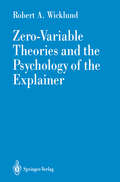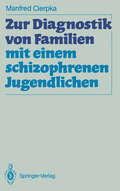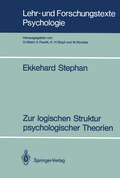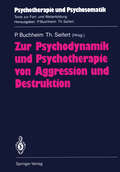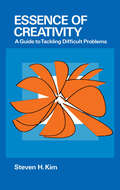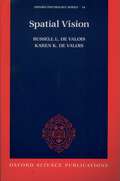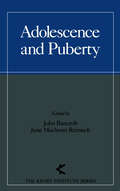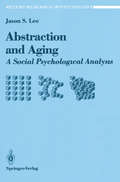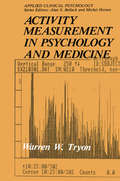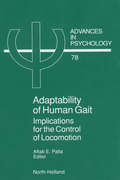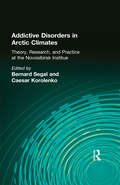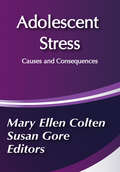- Table View
- List View
Work Motivation (Applied Psychology Series)
by Uwe Kleinbeck Hans-Henning Quast Henk Thierry Hartmut HackerA unique compendium of international investigations into motivation and performance, this book offers chapters by industrial and organizational psychologists from the United States, Europe, Australia, and Japan as they share their theories, concepts, empirical evidence, and practical evidence regarding the subject. The volume focuses on three distinct themes: * the relationship between motivation and performance * practical examples of building and strengthening the motivating potential with particular attention paid to productivity and the health of the employees * the development of work motivation over time and the change of the relative importance of central variables Work Motivation provides an exceptional blend of modern theoretical approaches, technologically sound techniques for solving practical problems, and empirical results to prove theoretical and technical validities.
Work Motivation (Applied Psychology Series)
by Hans Henning Quast Uwe Kleinbeck Henk Thierry Cker Hartmut HA unique compendium of international investigations into motivation and performance, this book offers chapters by industrial and organizational psychologists from the United States, Europe, Australia, and Japan as they share their theories, concepts, empirical evidence, and practical evidence regarding the subject. The volume focuses on three distinct themes: * the relationship between motivation and performance * practical examples of building and strengthening the motivating potential with particular attention paid to productivity and the health of the employees * the development of work motivation over time and the change of the relative importance of central variables Work Motivation provides an exceptional blend of modern theoretical approaches, technologically sound techniques for solving practical problems, and empirical results to prove theoretical and technical validities.
Working with Children in Art Therapy
by Caroline Case Tessa DalleyWorking with Children in Art Therapyis a collection of papers by ten art therapists working in the major child care agencies as part of a professional team. Each paper describes a different theoretical perspective and clinical setting with an emphasis on the language of art in art therapy and ways of understanding non-verbal communication. Contributions cover working with children in psychiatric clinics within the National Health Service, in mainstream and special schools, and in the social services.
Working with Children in Art Therapy
by Caroline Case Tessa DalleyWorking with Children in Art Therapy is a collection of papers by ten art therapists working in the major child care agencies as part of a professional team. Each paper describes a different theoretical perspective and clinical setting with an emphasis on the language of art in art therapy and ways of understanding non-verbal communication. Contributions cover working with children in psychiatric clinics within the National Health Service, in mainstream and special schools, and in the social services.
Working with Children in Art Therapy
by Caroline Case Tessa DalleyWorking with Children in Art Therapy is a collection of papers by ten art therapists working in the major child care agencies as part of a professional team. Each paper describes a different theoretical perspective and clinical setting with an emphasis on the language of art in art therapy and ways of understanding non-verbal communication. Contributions cover working with children in psychiatric clinics within the National Health Service, in mainstream and special schools, and in the social services.
Working with Children in Art Therapy (PDF)
by Caroline Case Tessa DalleyWorking with Children in Art Therapyis a collection of papers by ten art therapists working in the major child care agencies as part of a professional team. Each paper describes a different theoretical perspective and clinical setting with an emphasis on the language of art in art therapy and ways of understanding non-verbal communication. Contributions cover working with children in psychiatric clinics within the National Health Service, in mainstream and special schools, and in the social services.
Zero-Variable Theories and the Psychology of the Explainer
by Robert A. WicklundIn Zero-Variable Theories, Dr. Robert Wicklund invites the reader to consider the psychological perspective of the "explainer". In examining the over-simplifications that have become dominant in modern psychology, the author points to such factors as competition with other explainers and pressure to offer and promulgate a unique explanation. The explainer is characterized as equating theory with simple, fixed categories, and as defending those categories as one would defend a personal territory, fending off competing explainers through mis-use of statistical devices. The end result is the formulation of theories that neglect the perspectives of those whose behaviors are to be explained, and which simultaneously exclude psychological variables.
Zur Diagnostik von Familien mit einem schizophrenen Jugendlichen
by Manfred CierpkaDieses Buch enthält die Ergebnisse einer empirischen Studie, in der Familien mit einem schizophrenen Jugendlichen mit Familien mit einem neurotischen und klinisch unauffälligen Jugendlichen verglichen wurden. Ziel dieser familiendiagnostischen Studie ist es, eine Gewichtung von individuellen und familiären Faktoren vornehmen zu können, die zur Entstehung und Aufrechterhaltung von seelischen Krankheiten beitragen. Anhand eines bewährten Fragebogeninventars, illustriert mit Fallbeispielen, wird dem Familientherapeuten die Möglichkeit gegeben, sich ein Bild von den Schwächen und Stärken einer Familie zu machen, so daß er für den therapeutischen Prozeß an den jeweiligen Schwachstellen ansetzen und auf den Familienstärken aufbauen kann. Die in dieser Studie vorgestellte empirisch objektivierende Methodik in der Familiendiagnostik, durchgeführt über mehrere Ebenen, ist neu im deutschsprachigen Raum.
Zur logischen Struktur psychologischer Theorien (Lehr- und Forschungstexte Psychologie #33)
by Ekkehard StephanDie von Sneed und Stegmüller begründete strukturalistische Wissenschaftstheorie erlaubt es, die Struktur und Dynamik empirischer Theorien hinreichend differenziert und zugleich realistisch zu beschreiben. Die vorliegende Arbeit will zeigen, daß das strukturalistische Theorienkonzept mit Gewinn auch auf psychologische Theorien übertragen werden kann. Dazu wird zunächst eine elementare Einführung in dieses Theorienkonzept gegeben, die auch dem nicht einschlägig vorgebildeten Leser die Rezeption dieses Ansatzes ermöglichen soll. Exemplarisch werden dann drei psychologische Theorien aus strukturalistischer Sicht dargestellt: Die Balancetheorie von F. Heider, die Konformitätstheorie von B.P. Cohen und ein komplexes Netz psychologischer Nutzentheorien. Letzteres enthält u.a. eine für viele Einstellungs- und Lerntheorien grundlegende Theorie des subjektiv erwarteten Nutzens, die Prospect-Theorie von Kahneman und Tversky, sowie die Theorien der Leistungsmotivation von Lewin und Atkinson. Es wird deutlich, wie diese Theorien zusammenhängen, welchen empirischen Gehalt und welche Anwendungsbereiche sie haben. Damit wird der Forderung nach einer stärkeren Integration der psychologischen Theorienbildung Rechnung getragen. Ferner werden die methodologischen und methodischen Erträge der Rekonstruktionen jeweils deutlich herausgearbeitet, so daß die Fruchtbarkeit einer strukturalistischen Auffassung psychologischer Theorien sichtbar wird.
Zur Psychodynamik und Psychotherapie von Aggression und Destruktion (Psychotherapie und Psychosomatik)
by M. V. Bergmann B. Buddeberg-Fischer H. Dieckmann M. Hirsch P. L. Janssen R. Plassmann H. Thomä J. WeberDas Buch behandelt die Fragen menschlicher Aggression und Destruktion aus dem Gesichtswinkel der Psychotherapie und Psychoanalyse. Maßgebende Autoren, die bei den 39. Lindauer Psychotherapie Wochen Hauptvorträge gehalten haben, kommen in diesem Buch zu Wort und geben so einen Einblick in ein sehr komplexes Gebiet menschlichen Erlebens und Verhaltens, der in dieser Zusammenstellung nur selten zu finden ist. Das Besondere des Buches besteht darin, daß der weitgespannte Rahmen von den traumatischen Erlebnissen der Überlebenden des Holocaust über Gewalttaten in der Familie und klinische Phänomene der Aggressionsverarbeitung durch Selbstbeschädigung bis hin zur theoretischen und psychoanalytischen Aufarbeitung der Hintergründe reicht. Ziel des Buches ist es, nicht nur Psychotherapeuten einen guten Überblick zu vermitteln, sondern auch Anregung für die Bearbeitung dieser Themen im medizinischen und psychologischen Hochschuluntericht zu geben. Da die Autoren unterschiedliche Standpunkte vertreten und das Thema von theoretischen, historischen, forensischen, klinischen und therapeutischen Gesichtspunkten her betrachten, wird in dieser konzentrierten Kurzform eine aktuelle und spannende Information zu den Problemen von Aggression und Destruktion in zwischenmenschlichen Beziehungen angeboten.
Holland's Guide to Psychoanalytic Psychology and Literature-and-Psychology
by Norman N. HollandAs psychoanalysis becomes more and more important to literary studies and the accompanying literature bulks larger and larger, students often feel overwhelmed, not knowing where to turn for readings that will open up the subject. Holland's Guide to Psychoanalytic Psychology and Literature-and-Psychology offers an ingenious solution to this problem. It provides concise outlines of all types of psychoanalytic theory and shows how they apply to literary criticism. The outlines point in turn to further, more specific readings--articles, essays, and books--which can then be located by two extensive bibliographies that follow the discussion. These offer materials that range from the earliest Freud to the latest cognitive science and include dozens of bibliographic aids. Holland integrates these suggested readings with lively, detailed comments on various psychologies as they relate to literature. He is thus able to guide students easily to the precise subject they wish to study, be it Jungian criticism, ego psychology, feminist psychoanalysis, psychoanalytic film theory, or interpretation of some specific text. Holland also offers a bracing discussion of reader-response criticism and a lucid guide to the work of Jacques Lacan. A trenchant epilogue defends the psychological approach, suggesting which points in psychoanalytic theory will work for literary critics, and which will not. The only such guidebook for students of psychoanalytic literary theory and literary criticism, Holland's Guide will also prove an invaluable aid for those studying psychoanalysis and psychology.
Essence of Creativity: A Guide to Tackling Difficult Problems
by Steven KimChallenging problems both attract and repel us. They frustrate us, accelerate our pulses, cause ulcers, and perhaps even curtail our lifespans. On the other hand, the knotty problems of life offer us food for thought, sustaining our creativity, and adding emotional spice to the human experience. We encounter difficult tasks day in and day out. The solutions to these problems must be sought with resourcefulness and creativity, for until now we have had little insight into the nature of these tasks, and even less into methods for resolving them. This unique book explores the nature of challenging problems in all walks of life, and describes the creative techniques for addressing them. It is particularly relevant for problems that admit no obvious solution, whether they concern scientific knowledge, technology, the arts, or social situations. By understanding the dynamics of problem solving in general, the author argues, we can better organize the pursuit of specific projects. The initial phase involves crystallizing our objectives and developing a coherent plan. The next step is to evaluate the results and determine whether the work should be concluded, begun anew, or given up altogether. With this general strategy, even seemingly overwhelming problems can be approached systematically and efficiently. The author goes beyond the normal distinction between routine and innovative activities, defining the role of creativity in novel decision-making. In addition, he distills the existing literature on creativity, innovation, and project management to present a concise set of strategies and practices that can be applied in a myriad of settings ranging from university laboratories to corporate planning centers. For the sake of concreteness, a number of examples from research and development environments demonstrate the book's basic principles in action, showing how even the most difficult problems can yield to knowledgeable ingenuity. Written in a clear, readable style, Essence of Creativity will appeal to a broad spectrum of readers: engineers, business managers, computer scientists, executives, cognitive psychologists, and educators in many fields, as well as general readers seeking effective ways to handle difficult problems.
Adult Development: Volume 2: Models and Methods in the Study of Adolescent and Adult Thought
by Michael L. CommonsIn recent years, researchers have begun to focus attention on postformal thought--the development of thought in late adolescence and adulthood--questioning Piaget's early terminus of structural development in adolescence. This volume brings together the works of distinguished authors in the field of postformal-operational cognitive, social, and perceptual development to examine the models and methodology used to investigate postformal thought. The contributors represent the variety of approaches that characterize this body of research, while, at the same time, seeking to unify this diverse literature with a common language. An ideal text for advanced courses in adult development, this volume is also a primary reference for developmental and educational psychologists and students working in the fields of cognitive development, adolescent and adult development, and lifespan development.Divided into four parts, the volume begins by examining both Piagetian and nonstructural models of adult cognitive development, considering them in light of current research developments. Individual papers address models of equilibrium, knowledge, reflective judgment, ego-development, and consciousness. In Part II, the contributors discuss the measurement and comparison of cognitive development in adults, exploring such topics as construct validity and theories of adult development, the structural and developmental relations between formal and postformal capacities, and the relationship between Piagetian and Kohlbergian stages. The third section assesses the research and theory of adult reasoning in the moral domain, while the concluding chapter investigates critical evaluations of postformal research. Numerous tables and figures enhance the discussions.
Spatial Vision (Oxford Psychology Series)
by Russell L. DeValois Karen K. DeValoisThis volume presents an integrated view of how we perceive the spatial relations in our visual world, covering anatomical, physiological, psychophysical, and perceptual aspects. The authors discuss the visual system primarily in terms of spatial frequency analysis using a linear systems approach. They review evidence supporting a local, patch-by-patch spatial frequency filtering of visual information rather than the global Fourier analysis other researchers have proposed. A separate chapter addresses the special issues surrounding color vision, and a brief, nonmathematical introduction to linear systems analysis is included for the uninitiated reader.
Mental Representations: A Dual Coding Approach (Oxford Psychology Series)
by Allan PaivioIn this volume Professor Paivio updates his influential theory of cognition and provides a systematic treatise on the structure of cognitive representations and their dynamic functions in thought and behavior.
The Biopsychology of Mood and Arousal
by Robert E. ThayerWhat is the biological function of daily mood variations? What is the relationship between mood and such factors as exercise, time of day, nutrition, stress, and illness? Drawing on his own wide-ranging research concerning subjective assessments of mood and on extensive research by others, Dr. Thayer presents a comprehensive theory of normal mood states, viewing them as subjective components of two biological arousal systems, one which people find energizing, and the other which people describe as producing tension. The author explains these two mood effects in relation to a complex relationship between energy and tension. Relevant research is systematically reviewed, and moods are analyzed in relation to circadian rhythms, exercise, nutrition, sleep, stress, and cognition. Perceptual and motivational effects of mood are also discussed, as are measurement and research design issues. Unique in its depth and comprehensiveness, this book will be of interest not only to researchers in psychology, biology, and medicine, but its clear style of presentation and the practical activities suggested for mood regulation will make it interesting to general readers as well.
Adolescence and Puberty (The Kinsey Institute Series)
by John Bancroft June Machover ReinischThis wide-ranging volume presents an in-depth picture of adolescent sexuality and behavior. As perhaps the most vital period in human development, adolescence is a time of complex, often difficult interactions between diverse influences. Here, nineteen scientists representing ten disciplines explore the biological, psychological, and cultural factors involved in the onset of puberty and its associated emotional changes. Patterns of adolescent sexual behavior are viewed in cross-cultural perspective, psychiatric disorders are considered, and trends in adolescent sexual activity, contraception, and pregnancy are described. Key legal and social dilemmas are also explored. This is the third volume in a groundbreaking series from the Kinsey Institute, which has as its aim the study of topics relating to sex, gender, and reproduction that require an interdisciplinary approach. Previous volumes in the series include Homosexuality/Heterosexuality and Masculinity/Femininity.
Abstraction and Aging: A Social Psychological Analysis (Recent Research in Psychology)
by Jason S. LeeAbstraction is one facet of intellectual functioning. The study of abstraction allows extremely valuable insights into human intelligence. While this monograph indicates that the ability to think abstractly declines slightly with age, there are a number of variables determining abstract thinking and its relation to intelligence over the life-span. This monograph defines abstraction from all angles of thought, contrasting it with high-order thinking and stereotyped thinking; it discusses and evaluates tests of abstract thinking; and it presents new findings in sociological and psychological research on abstraction.
Activity Measurement in Psychology and Medicine (Nato Science Series B:)
by Warren W. TryonIn his treatment of activity measurement in the fields of medicine and psychology, Tryon gives us a book that clearly accomplishes the three purposes set out in its preface. The reader is definitely encouraged to wrestle with the concepts ofbehavior and activity in terms of "dynamic physical quantities." Moreover, the reader cannot help but become familiarized with the technology available for performing activity measurements. Motivation to use some of this technology is enhanced by the very extensive summary of other people's uses of it provided throughout the book. Readers may find the book provocative on a number of Ievels. It is concep tually provocative to those of us struggling with understanding basic issues in the assessment and measurement of behavior. It is practically provocative to those of us working with various forms of behavioral difference, especially in clinical popula tions. The book provokes because it is essentially an unfinished exploration, open ing us to numerous pathways that, when traveled, reveal still more paths to explore. In this sense the book should be heuristically useful both in the more traditional empirical sense, and in terms of its Stimulation of conceptual discussion.
Adaptability of Human Gait: Implications for the Control of Locomotion (ISSN #Volume 78)
by A. E. PatlaA large number of volumes have been produced summarizing the work on generation and control of rhythmic movements, in particular locomotion. Unfortunately most of them focus on locomotor studies done on animals. This edited volume redresses that imbalance by focusing completely on human locomotor behaviour. The very nature of the problem has both necessitated and attracted researchers from a wide variety of disciplines ranging from psychology, neurophysiology, kinesiology, engineering, medicine to computer science. The different and unique perspectives they bring to this problem provide a comprehensive picture of the current state of knowledge on the generation and regulation of human locomotor behaviour.A common unifying theme of this volume is studying the adaptability of human gait to obtain insights into the control of locomotion. The intentional focus on "adaptability" is meant to draw attention to the importance of understanding the generation and regulation of "skilled locomotor behaviour" rather than just the generation of basic locomotor patterns which has been the major focus of animal studies. The synthesis chapter at the end of the volume examines how the questions posed, the technology, and the experimental and theoretical paradigms have evolved over the years, and what the future has in store for this important research domain.
Addictive Disorders in Arctic Climates: Theory, Research, and Practice at the Novosibirsk Institute
by Bernard SegalDiscover fresh perspectives on alcoholism treatment and research with this enlightening new book describing the work of researchers at the Novosibirsk Medical Institute, USSR. By using specific examples of their studies in Siberia, the reserachers offer an innovative approach to the treatment of addictive disorders in general. Instead of focusing on the drinking behavior itself, the treatment focuses on the relation of the problem to the interaction of economic, social, and psychological factors. To address the question of whether alcoholics should all be treated in the same way, or if alcholism treatment should be more individualized in approach, chapters are devoted to the differences between alcoholism in women, adolescents, and alchoholics who are afflicted with “rapid development of alcholism syndrome.” The research examples in Addictive Disorders in Arctic Climates benefits professionals involved in the treatment of alcholism by introducing new perspectives and broadening contemporary research.
Addictive Disorders in Arctic Climates: Theory, Research, and Practice at the Novosibirsk Institute
by Bernard SegalDiscover fresh perspectives on alcoholism treatment and research with this enlightening new book describing the work of researchers at the Novosibirsk Medical Institute, USSR. By using specific examples of their studies in Siberia, the reserachers offer an innovative approach to the treatment of addictive disorders in general. Instead of focusing on the drinking behavior itself, the treatment focuses on the relation of the problem to the interaction of economic, social, and psychological factors. To address the question of whether alcoholics should all be treated in the same way, or if alcholism treatment should be more individualized in approach, chapters are devoted to the differences between alcoholism in women, adolescents, and alchoholics who are afflicted with “rapid development of alcholism syndrome.” The research examples in Addictive Disorders in Arctic Climates benefits professionals involved in the treatment of alcholism by introducing new perspectives and broadening contemporary research.
Adolescent Group Therapy: A Social Competency Model
by Lucille Gordon Robert V. Heckel George R. HolmesThis book offers a health-oriented, integrative approach to adolescent group therapy. George R. Holmes and his associates believe that promoting social competency in each adolescent group member is central to successful therapy. The enablement of interpersonal skills neutralizes the environmentally sponsored psychopathology that adolescents use to survive. The authors also emphasize the co-therapy relationship. They offer recommendations for supervising trainee therapists and for applying their model to other contexts, such as high schools.The authors discuss strategies developed in their clinical work, covering such issues as scapegoating, silence, and withdrawal. They explore how processes, roles, and meaningful issues change over the life of the group. Social competency should be the main focus, they argue: it is essential to nurturing self-parenting skills and a healthy identity. The co-therapy relationship--the interaction between co-therapists and among co-therapists and group members--also greatly determines therapeutic change. The book includes recommendations for supervising trainee therapists and for applying this model to other contexts, such as high schools. Adolescent Group Therapy will be of interest to students and to teachers and professionals in psychology, counseling, vocational rehabilitation, social work, nursing, education, and child and adolescent psychiatry.
Adolescent Stress: Causes and Consequences (Social Institutions And Social Change Ser.)
by Mary ColtenAdolescent Stress concentrates on a range of major problems—those of a normal developmental nature as well as those of poor adaptation—identified in adolescents.
Adolescent Stress: Causes and Consequences
by Mary ColtenAdolescent Stress concentrates on a range of major problems—those of a normal developmental nature as well as those of poor adaptation—identified in adolescents.



